Introduction
Contact centers are at a pivotal juncture—facing mounting customer expectations, rising operational costs, and the need for 24/7 support across multiple channels. Artificial Intelligence (AI) is emerging as a transformative force, automating routine tasks, enhancing agent performance, and delivering personalized customer experiences. This comprehensive guide delves into how AI is revolutionizing contact center operations, providing tangible benefits and addressing implementation challenges.
What is AI and Why Does It Matter in Contact Centers?
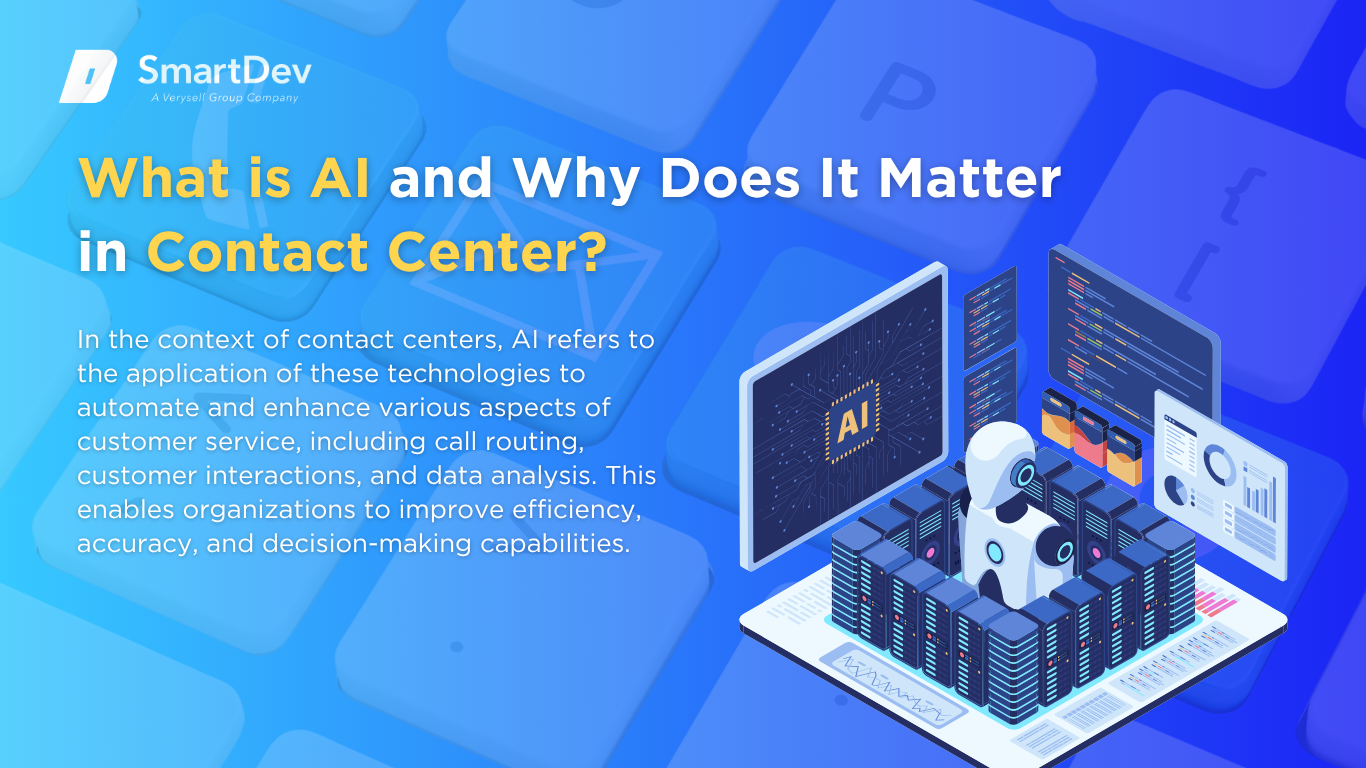
Definition of AI and Its Core Technologies
Artificial Intelligence (AI) encompasses computer systems designed to perform tasks that typically require human intelligence, such as learning, reasoning, problem-solving, and decision-making. Core technologies include machine learning, natural language processing (NLP), and computer vision.
In the context of contact centers, AI refers to the application of these technologies to automate and enhance various aspects of customer service, including call routing, customer interactions, and data analysis. This enables organizations to improve efficiency, accuracy, and decision-making capabilities.
The Growing Role of AI in Transforming Contact Centers
AI is reshaping contact center operations by automating repetitive tasks, providing real-time assistance to agents, and delivering personalized customer experiences. For instance, AI-powered chatbots can handle routine inquiries, freeing up human agents to focus on more complex issues. Businesses in industries like retail and banking are already leveraging AI-driven automation in customer experience.
Moreover, AI enables real-time sentiment analysis, allowing agents to adjust their approach based on customer emotions. This leads to improved customer satisfaction and loyalty. Companies are also leveraging AI for predictive analytics, forecasting customer behavior, and proactively addressing potential issues. This strategic use of AI enhances decision-making and operational efficiency.
Key Statistics and Trends Highlighting AI Adoption in Contact Centers
AI is Becoming Integral to Customer Interactions: By 2025, AI is projected to handle 95% of all customer interactions, encompassing both voice and text channels. This shift underscores the growing reliance on AI to manage routine inquiries, allowing human agents to focus on more complex issues that require empathy and critical thinking.
Generative AI is Enhancing Customer Experience: Gartner predicts that 80% of customer service and support organizations will integrate generative AI technologies to enhance customer experiences. Generative AI enables more natural and personalized interactions, improving customer satisfaction and loyalty.
AI Adoption is Expanding Across Business Functions: According to McKinsey, 78% of organizations use AI in at least one business function, up from 72% in early 2024. This trend indicates a broadening acceptance of AI’s value across various departments, including IT, marketing, sales, and customer service.
AI is Driving Operational Efficiency: ServiceNow reported that its AI agents handle 80% of customer support inquiries autonomously, leading to a 52% reduction in the time needed for complex case resolution and an estimated $325 million in annualized value from enhanced productivity. These efficiencies translate into significant cost savings and improved service levels.
Want to explore how AI can transform your sector? Discover real-world strategies for deploying smart technologies in contact centers. Visit How to Integrate AI into Your Business in 2025 to get started today and unlock the full potential of AI for your business!
Business Benefits of AI in Contact Centers
AI in contact centers isn’t just about cutting costs—it’s about elevating every layer of the customer service experience. From empowering agents with better tools to personalizing customer interactions at scale, AI unlocks real, strategic advantages.
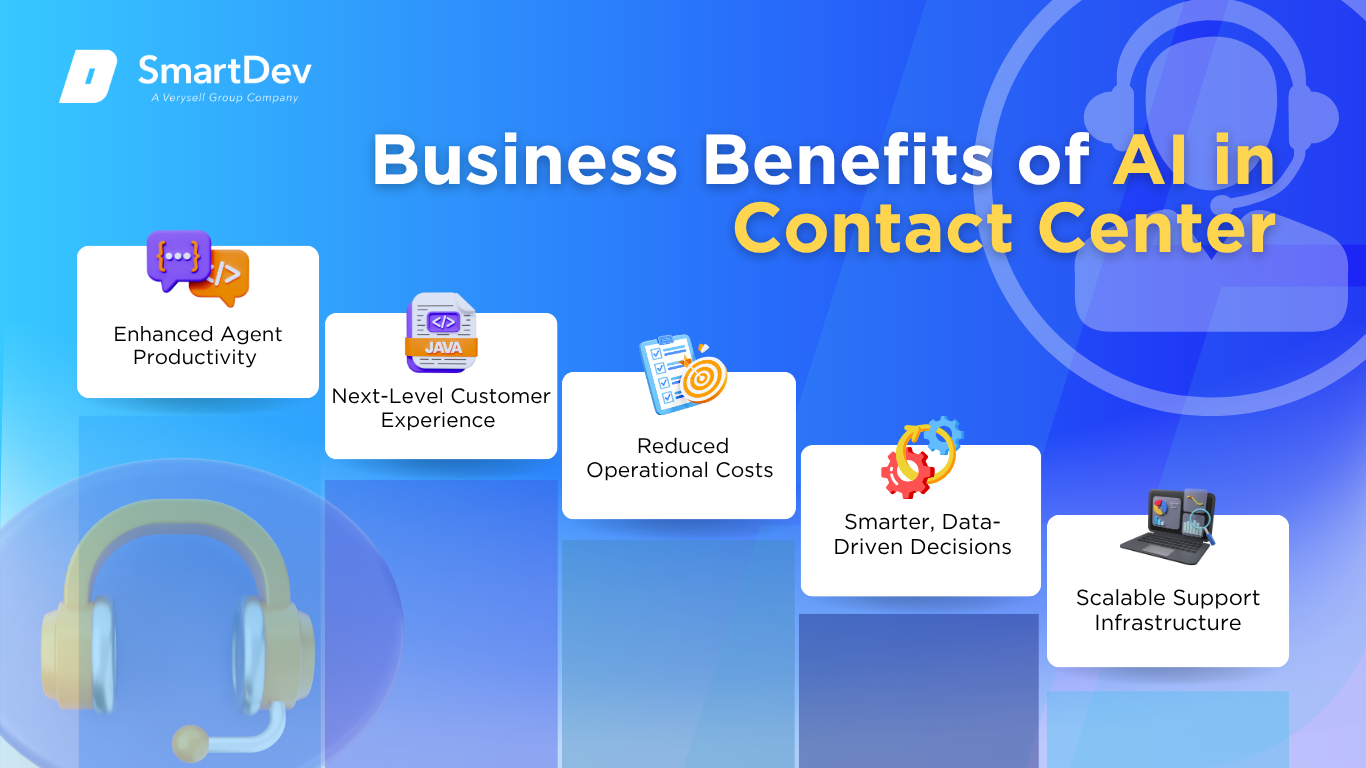
1. Enhanced Agent Productivity
Let’s face it—your agents are bogged down by repetitive tasks that don’t require human creativity or emotional intelligence. AI handles routine functions like call routing, identity verification, and data entry, allowing agents to focus on what really matters: solving complex problems and delivering empathetic service. Virtual assistants and AI-driven knowledge bases give agents instant access to relevant information during live interactions. The result? Shorter handle times, higher resolution rates, and more engaged team members who aren’t burned out by answering the same questions all day.
2. Next-Level Customer Experience
In today’s customer-first world, personalization is no longer optional—it’s expected. AI powers hyper-personalized experiences by analyzing customer behavior, past interactions, and preferences in real time. Natural Language Processing (NLP) enables bots to understand context and sentiment, ensuring responses feel human, not robotic. Meanwhile, AI tools like real-time sentiment analysis coach agents as they speak—helping de-escalate tense situations before they spiral. This empathy at scale leads to happier customers and stronger loyalty.
3. Reduced Operational Costs
AI helps contact centers do more with less. Automated workflows reduce reliance on large support teams for basic queries, lowering staffing costs without compromising service quality. Plus, AI-driven forecasting and scheduling tools optimize workforce planning, minimizing overstaffing and idle time. When deployed thoughtfully, AI isn’t a cost—it’s a strategic investment that drives long-term savings and efficiency.
4. Smarter, Data-Driven Decisions
Every customer call, chat, and email is a goldmine of insights—but only if you can extract and analyze it. AI turns unstructured data into actionable intelligence, surfacing patterns in customer issues, feedback, and agent performance. These insights inform everything from training programs to product improvements. Predictive analytics goes a step further, helping you anticipate customer needs before they even reach out—building a proactive, not reactive, service model.
5. Scalable Support Infrastructure
Whether it’s a holiday rush or a product launch, sudden spikes in volume are a reality. AI makes scaling support seamless. Virtual agents can handle thousands of simultaneous interactions, ensuring no customer is left hanging. And as your business grows, AI systems grow with you—no need for constant rehiring or retraining. This agility allows contact centers to remain responsive and resilient in any climate.
Artificial Intelligence (AI) is emerging as a transformative force, automating routine tasks, enhancing agent performance, and delivering personalized customer experiences. Learn more about the impact of conversational AI on customer experience.
Challenges Facing AI Adoption in Contact Centers
While the potential is huge, rolling out AI in your contact center isn’t without hurdles. Success depends on a clear strategy, the right tech stack, and thoughtful change management.
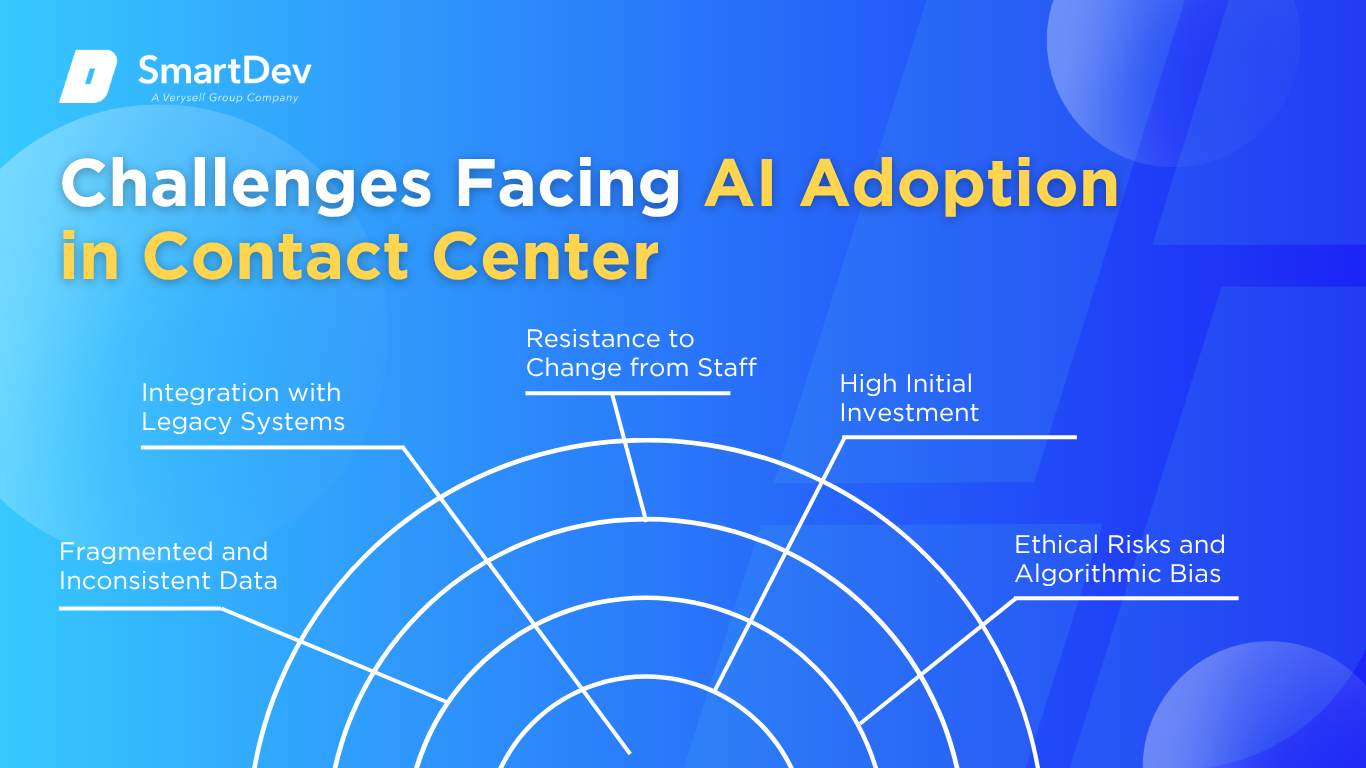
1. Fragmented and Inconsistent Data
AI is only as smart as the data it’s trained on.
Many contact centers struggle with data that’s siloed across CRMs, ticketing systems, and spreadsheets.
This fragmentation makes it tough to build accurate, AI-driven models.
To fix this, companies need to invest in data consolidation and cleansing—creating a single source of truth that AI can reliably learn from.
Without it, you risk decisions based on outdated or misleading information.
2. Integration with Legacy Systems
Let’s be honest: most contact centers aren’t built on shiny new platforms.
Integrating AI with aging infrastructure can be messy and expensive.
APIs might not exist, custom development is often required, and systems may not talk to each other well.
Solution? Choose AI tools with strong interoperability and prioritize vendors that offer out-of-the-box integrations with your current tech stack.
Think long-term: modular, cloud-native systems are easier to evolve alongside your AI strategy.
3. Resistance to Change from Staff
AI can spark anxiety among employees—fear of job loss, uncertainty about new workflows, or mistrust in automated decisions.
These are real concerns that deserve real responses.
The key is transparency and training.
Involve your teams early, explain how AI enhances their roles, and give them the skills to succeed in a tech-augmented environment.
When agents feel supported, they become champions—not critics—of AI.
4. High Initial Investment
AI implementation isn’t cheap.
Between software, infrastructure upgrades, and change management, the upfront cost can be daunting—especially for small and midsize centers.
The solution lies in phased rollouts and ROI-driven planning.
Start with use cases that deliver fast wins—like automating FAQs or routing—and scale from there.
This allows stakeholders to see tangible value early, building momentum (and budgets) for broader adoption.
5. Ethical Risks and Algorithmic Bias
AI systems can inadvertently amplify biases present in training data, leading to unfair treatment or discriminatory outcomes—especially in areas like sentiment scoring or prioritization.
Responsible AI governance is critical.
Regular audits, diverse training datasets, and clear escalation protocols help ensure fairness and transparency.
Customers trust you with their data—ethical AI helps you earn and keep that trust.
And the important thing is that a business-oriented guide to responsible AI and ethics offers practical insights on deploying AI responsibly and transparently, especially when public trust is at stake.
Specific Applications of AI in Contact Centers
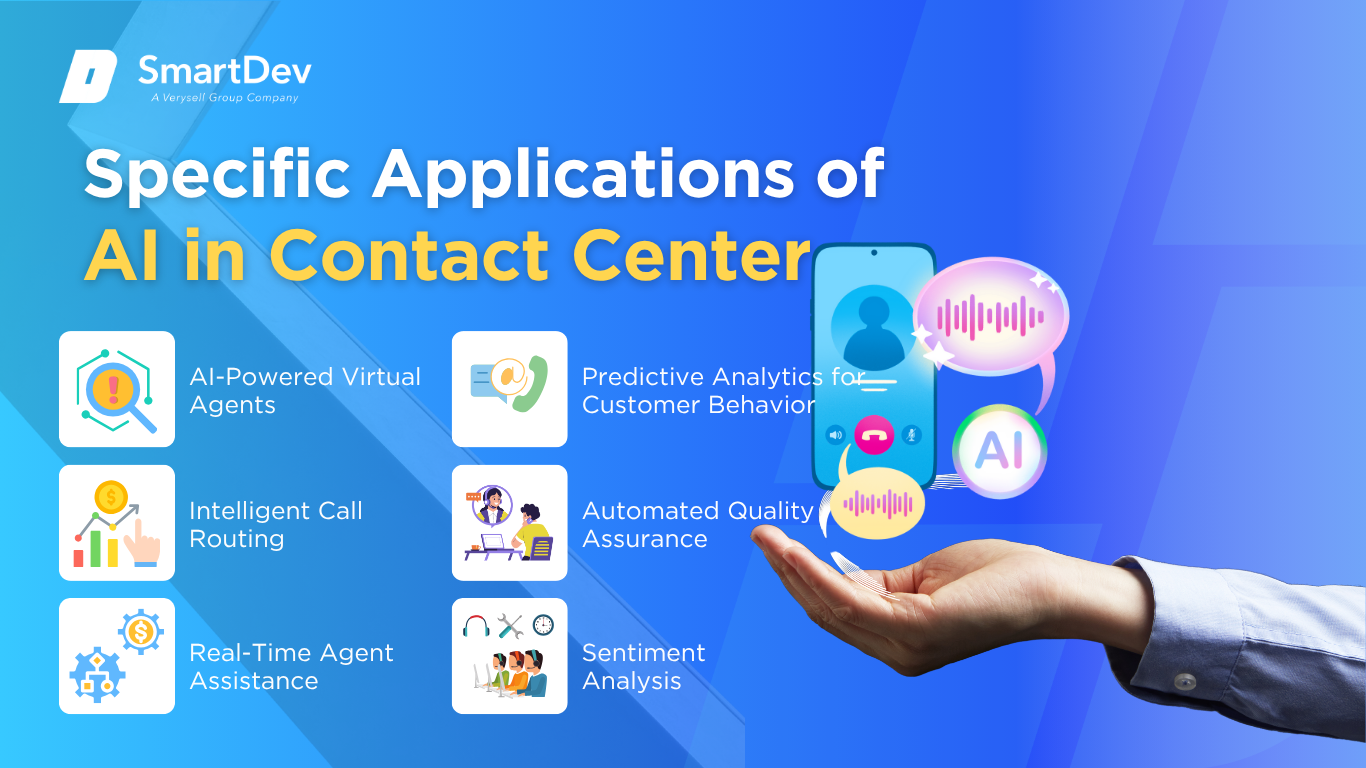
1. AI-Powered Virtual Agents
AI-powered virtual agents, including chatbots and voice assistants, handle routine customer inquiries, reducing the workload on human agents.
These agents utilize Natural Language Processing (NLP) and machine learning to understand and respond to customer queries effectively.
By integrating with backend systems, they provide instant responses, improving customer satisfaction and reducing wait times.
For instance, eHealth employs AI voice agents to manage high call volumes and after-hours inquiries.
These agents, powered by advanced speech-to-text and text-to-speech models, offer human-like interactions, enhancing the customer experience.
The adoption of such AI solutions has led to increased efficiency and customer satisfaction.
2. Intelligent Call Routing
Intelligent call routing leverages AI to direct customer calls to the most appropriate agent based on various factors like customer history, agent expertise, and sentiment analysis.
This ensures that customers are connected to agents best suited to resolve their issues, enhancing first-call resolution rates.
Zendesk utilizes AI for intelligent routing, analyzing customer intent and sentiment to match inquiries with the right agents.
This approach minimizes transfers and reduces customer wait times, leading to improved service efficiency.
3. Real-Time Agent Assistance
AI provides real-time support to agents during customer interactions by offering suggestions, relevant information, and prompts.
This assistance helps agents respond more effectively, reduces response times, and enhances the overall quality of service.
Uniphore’s U-Assist platform delivers real-time transcriptions and alerts during calls, enabling agents to access necessary information promptly.
This real-time support improves agent performance and customer satisfaction.
4. Predictive Analytics for Customer Behavior
Predictive analytics uses AI to analyze historical customer data and predict future behaviors, enabling proactive customer service.
By anticipating customer needs, businesses can offer timely solutions, enhancing customer loyalty and satisfaction.
For example, IBM’s AI solutions analyze customer interactions to predict potential issues, allowing businesses to address concerns before they escalate.
This proactive approach leads to improved customer retention and reduced churn rates.
5. Automated Quality Assurance
AI automates the quality assurance process by analyzing customer interactions to assess agent performance, compliance, and customer satisfaction.
This automation enables consistent and objective evaluations, identifying areas for improvement and training needs.
Google’s Contact Center AI evaluates every customer interaction against business and compliance criteria, providing insights into agent performance and customer experiences.
This comprehensive analysis helps in enhancing service quality and operational efficiency.
6. Sentiment Analysis
Sentiment analysis employs AI to detect and interpret customer emotions during interactions.
By understanding customer sentiments, businesses can tailor their responses, address concerns promptly, and improve overall customer satisfaction.
Twilio’s AI solutions analyze customer sentiment in real-time, enabling agents to adjust their approach accordingly.
This emotional intelligence leads to more empathetic interactions and strengthens customer relationships.
Examples of AI in Contact Centers
Real-World Case Studies
Real-world applications of AI in contact centers demonstrate its transformative impact on customer service and operational efficiency.
For further insights, see personalized customer service through AI in fintech and beyond.

1. eHealth: Transforming Health Plan Selection with AI Voice Agents
eHealth faced the challenge of managing high call volumes, especially during after-hours, leading to long wait times and potential customer dissatisfaction.
The company needed a solution to provide timely and efficient customer support without significantly increasing operational costs.
To address this, eHealth implemented AI voice agents capable of handling customer inquiries around the clock.
These agents utilized advanced speech-to-text and text-to-speech technologies, along with natural language processing, to engage in human-like conversations with customers.
The AI system was designed to assist customers in comparing health plans and making informed decisions.
The introduction of AI voice agents led to a 100% answer rate for after-hours calls, effectively eliminating wait times.
Additionally, the percentage of callers expressing interest in purchasing a plan increased from 18.5% to 34.5%, highlighting the system’s effectiveness in guiding customers through the selection process.
Customer satisfaction also improved, with 60% of users rating their experience as exceptional.
2. Teleperformance: Enhancing Communication Clarity with Accent Neutralization
Teleperformance, a global leader in customer experience management, identified that language barriers and strong regional accents could hinder effective communication between agents and customers, potentially leading to misunderstandings and reduced customer satisfaction.
To overcome this, Teleperformance partnered with Sanas, a company specializing in real-time speech modification technology.
Together, they deployed an AI solution capable of neutralizing accents in real-time, allowing agents to communicate more clearly with customers.
This technology aimed to enhance understanding and reduce the cognitive load on customers during interactions.
The implementation of accent-neutralizing AI led to improved clarity in customer-agent communications, reducing call durations and enhancing overall customer satisfaction.
However, the initiative also sparked discussions around cultural identity and the ethical implications of modifying natural speech patterns.
Despite these concerns, the technology has been adopted by various international clients, including major companies like Apple and Samsung.
3. Commonwealth Bank: Reducing Wait Times and Enhancing Security with AI
Commonwealth Bank of Australia (CBA) aimed to improve customer service efficiency and enhance security measures amid increasing customer expectations and sophisticated fraud attempts.
CBA integrated AI-powered messaging systems into their contact centers to handle routine inquiries and reduce call center wait times.
Additionally, they employed AI-driven security features, such as NameCheck and CallerCheck, to proactively identify and prevent fraudulent activities.
The bank also utilized AI to streamline internal processes, like automating annual credit reviews for business customers.
The AI initiatives resulted in a 40% reduction in call center wait times, significantly improving customer experience.
Security measures led to a 50% decrease in customer scam losses and a 30% drop in fraud reports.
Furthermore, automating annual reviews reduced the time required from 14 hours to just two hours, showcasing substantial operational efficiency gains.
Innovative AI Solutions
Emerging AI technologies are continuously reshaping contact center operations, offering new avenues for enhancing customer service.
Generative AI for Enhanced Customer Interactions
Generative AI models are being utilized to create more natural and responsive customer interactions.
These AI systems can generate human-like responses, improving the quality of automated customer service and reducing reliance on scripted interactions.
By understanding context and intent, generative AI enhances the personalization of customer engagements.
Real-Time Translation Services
AI-powered real-time translation services enable contact centers to support multiple languages seamlessly.
This capability broadens the reach of customer service operations and ensures effective communication with a diverse customer base.
It allows businesses to cater to global markets without language barriers.
Predictive Dialing Systems
AI-driven predictive dialing systems optimize outbound call campaigns by analyzing customer data to determine the best times to contact individuals.
This targeted approach increases the efficiency of outreach efforts and improves customer engagement rates.
By predicting customer availability and receptiveness, these systems enhance the effectiveness of contact center operations.
By embracing these innovative AI solutions, contact centers can enhance their service offerings, improve customer satisfaction, and achieve greater operational efficiency.
These examples underscore the importance of partnering with experts who understand both the technical intricacies and customer service dynamics.
If you’re exploring AI for your contact center, connecting with experienced implementation specialists can help uncover practical, high-impact opportunities tailored to your operations.
AI-Driven Innovations Transforming Contact Centers
Emerging AI technologies are continuously reshaping contact center operations, offering new avenues for enhancing customer service.
Generative AI for Enhanced Customer Interactions
Generative AI models are being utilized to create more natural and responsive customer interactions.
These AI systems can generate human-like responses, improving the quality of automated customer service and reducing reliance on scripted interactions.
By understanding context and intent, generative AI enhances the personalization of customer engagements.
Real-Time Translation Services
AI-powered real-time translation services enable contact centers to support multiple languages seamlessly.
This capability broadens the reach of customer service operations and ensures effective communication with a diverse customer base.
It allows businesses to cater to global markets without language barriers.
Predictive Dialing Systems
AI-driven predictive dialing systems optimize outbound call campaigns by analyzing customer data to determine the best times to contact individuals.
This targeted approach increases the efficiency of outreach efforts and improves customer engagement rates.
By predicting customer availability and receptiveness, these systems enhance the effectiveness of contact center operations.
By embracing these innovative AI solutions, contact centers can enhance their service offerings, improve customer satisfaction, and achieve greater operational efficiency.
These examples underscore the importance of partnering with experts who understand both the technical intricacies and customer service dynamics.
If you’re exploring AI for your contact center, connecting with experienced implementation specialists can help uncover practical, high-impact opportunities tailored to your operations.
How to Implement AI in Contact Centers
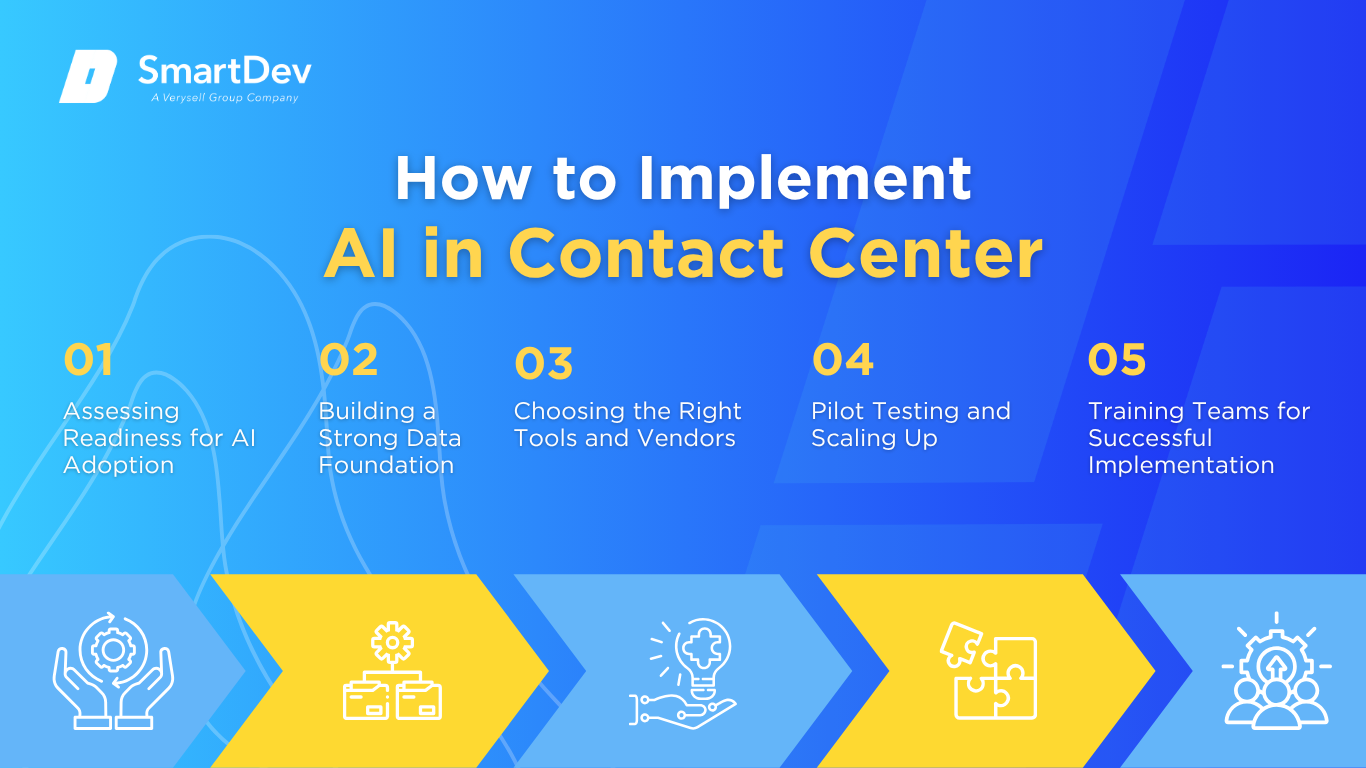
Step 1. Assessing Readiness for AI Adoption
Before integrating AI into your contact center, it’s crucial to assess your organization’s readiness.
Identify areas where AI can have the most significant impact, such as handling repetitive inquiries, managing call routing, or providing real-time analytics.
Evaluate your current infrastructure, data quality, and employee skill sets to determine the feasibility of AI implementation.
Engage stakeholders across departments to understand their needs and concerns.
This collaborative approach ensures that AI solutions align with business objectives and address specific challenges.
By thoroughly assessing readiness, organizations can develop a strategic roadmap for AI adoption that maximizes benefits and minimizes disruptions.
Step 2. Building a Strong Data Foundation
A robust data foundation is essential for successful AI integration.
Begin by collecting high-quality, relevant data from various sources, including customer interactions, feedback, and operational metrics.
Ensure that data is clean, accurate, and consistently formatted to facilitate effective analysis and model training.
Implement data management practices that prioritize security and compliance with regulations such as GDPR.
Establish protocols for data storage, access, and usage to maintain integrity and confidentiality.
By building a strong data foundation, contact centers can leverage AI to gain valuable insights and drive informed decision-making.
Step 3. Choosing the Right Tools and Vendors
Selecting appropriate AI tools and vendors is critical to the success of your implementation.
Evaluate solutions based on their compatibility with existing systems, scalability, and ease of integration.
Consider vendors with a proven track record in the contact center industry and those who offer robust support and training services.
Assess the flexibility of AI tools to adapt to your specific needs and workflows.
Opt for solutions that offer customization options and can evolve with your business requirements.
By carefully choosing the right tools and partners, organizations can ensure a smooth transition to AI-enhanced operations.
Step 4. Pilot Testing and Scaling Up
Initiate AI implementation with pilot projects targeting specific functions or departments.
This approach allows for testing and refinement of AI applications in a controlled environment, minimizing risks and disruptions.
Gather feedback from users and monitor performance metrics to assess effectiveness and identify areas for improvement.
Based on pilot results, develop a comprehensive plan for scaling AI solutions across the contact center.
Ensure that infrastructure, processes, and personnel are prepared to support expanded AI integration.
By adopting a phased approach, organizations can manage change effectively and maximize the benefits of AI technologies.
Step 5. Training Teams for Successful Implementation
Empowering employees with the necessary skills and knowledge is vital for successful AI adoption.
Provide comprehensive training programs that cover AI functionalities, usage guidelines, and best practices.
Encourage a culture of continuous learning to keep staff updated on evolving technologies and methodologies.
Foster collaboration between AI systems and human agents by emphasizing the complementary nature of their roles.
Highlight how AI can enhance job performance, reduce repetitive tasks, and allow employees to focus on more complex and value-added activities.
By investing in training and change management, organizations can facilitate a smooth transition to AI-enhanced operations.
Measuring the ROI of AI in Contact Centers
Key Metrics to Track Success
Evaluating the return on investment (ROI) of AI in contact centers involves monitoring various performance metrics.
Productivity improvements can be measured by analyzing reductions in average handling time, increased first-call resolution rates, and higher call volumes managed per agent.
Cost savings are evident through decreased labor expenses, reduced training costs, and lower error rates.
Customer satisfaction scores, such as Net Promoter Score (NPS) and Customer Satisfaction (CSAT) ratings, provide insights into the impact of AI on service quality.
Additionally, tracking employee engagement and retention rates can indicate how AI influences job satisfaction and workplace dynamics.
By comprehensively assessing these metrics, organizations can quantify the benefits of AI implementation.
Understanding ROI is possibly a challenge to many businesses and institutions as different in background, cost. So, if you need to dig deep about this problem, you can read AI Return on Investment (ROI): Unlocking the True Value of Artificial Intelligence for Your Business.
Case Studies Demonstrating ROI
Real-world implementations of AI in contact centers have yielded significant returns on investment, showcasing the transformative potential of these technologies.
H&M, a global fashion retailer, integrated AI-powered chatbots into their customer service operations.
Within six months, they observed a 70% resolution rate of customer queries without human intervention, a 25% increase in conversions during chatbot-assisted sessions, and a threefold improvement in response times.
These enhancements not only elevated customer satisfaction but also contributed to a noticeable uptick in sales revenue and a reduction in support costs.
NIB, an Australian health insurer, implemented an AI-driven digital assistant named Nibby.
This initiative led to a 60% reduction in the need for human customer service support and a 15% decrease in phone calls with agents.
These efficiencies translated into $22 million in savings since 2021, allowing NIB to manage growth without proportionally increasing staff numbers.
Verizon, a major telecommunications company, leveraged generative AI to enhance customer loyalty.
By accurately predicting the reasons behind 80% of incoming calls, they efficiently connected customers with the appropriate agents, reducing store visit durations by approximately seven minutes per customer.
This strategic use of AI aimed to prevent 100,000 customers from churning, thereby safeguarding revenue and enhancing customer satisfaction.
These case studies underscore the tangible benefits of AI integration in contact centers, including cost savings, improved customer experiences, and increased operational efficiency.
Common Pitfalls and How to Avoid Them
1. Poor Data Quality
AI systems rely heavily on high-quality data.
Inaccurate, incomplete, or biased data can lead to flawed AI outputs, undermining the effectiveness of the technology.
For instance, if customer interaction data lacks diversity, AI models may not generalize well, leading to subpar customer experiences.
To mitigate this, organizations should invest in robust data governance practices, including regular data audits, cleansing, and validation processes.
Every customer call, chat, and email is a goldmine of insights—but only if you can extract and analyze it.
AI turns unstructured data into actionable intelligence, surfacing patterns in customer issues, feedback, and agent performance—supporting more effective data-driven decision-making across contact center operations.
2. Lack of Clear Objectives
Implementing AI without well-defined goals can result in misaligned efforts and wasted resources.
Companies should establish specific, measurable objectives for AI initiatives, such as reducing average handling time by a certain percentage or increasing first-call resolution rates.
Clear goals provide direction and facilitate the assessment of AI’s impact on contact center performance.
3. Inadequate Employee Training
The introduction of AI can cause apprehension among staff, particularly if they fear job displacement.
Without proper training and communication, employees may resist adopting new technologies.
Organizations should offer comprehensive training programs that highlight how AI can augment human roles, alleviate repetitive tasks, and enhance job satisfaction.
Engaging employees as stakeholders in the AI adoption process fosters acceptance and collaboration.
4. Overlooking the Human Element
While AI can handle routine inquiries efficiently, complex or sensitive customer interactions often require human empathy and judgment.
Over-reliance on AI may lead to impersonal customer experiences.
A balanced approach that integrates AI for efficiency while preserving human touchpoints for nuanced interactions ensures a comprehensive customer service strategy.
5. Insufficient Monitoring and Evaluation
Failing to continuously monitor AI performance can result in unnoticed issues and missed opportunities for improvement.
Organizations should establish key performance indicators (KPIs) to assess AI effectiveness regularly.
Metrics such as customer satisfaction scores, resolution rates, and cost savings provide insights into AI’s impact and inform necessary adjustments.
By recognizing these common pitfalls and implementing strategies to address them, businesses can enhance the success of AI initiatives in contact centers, leading to improved customer experiences and operational efficiencies.
Future Trends of AI in Contact Centers
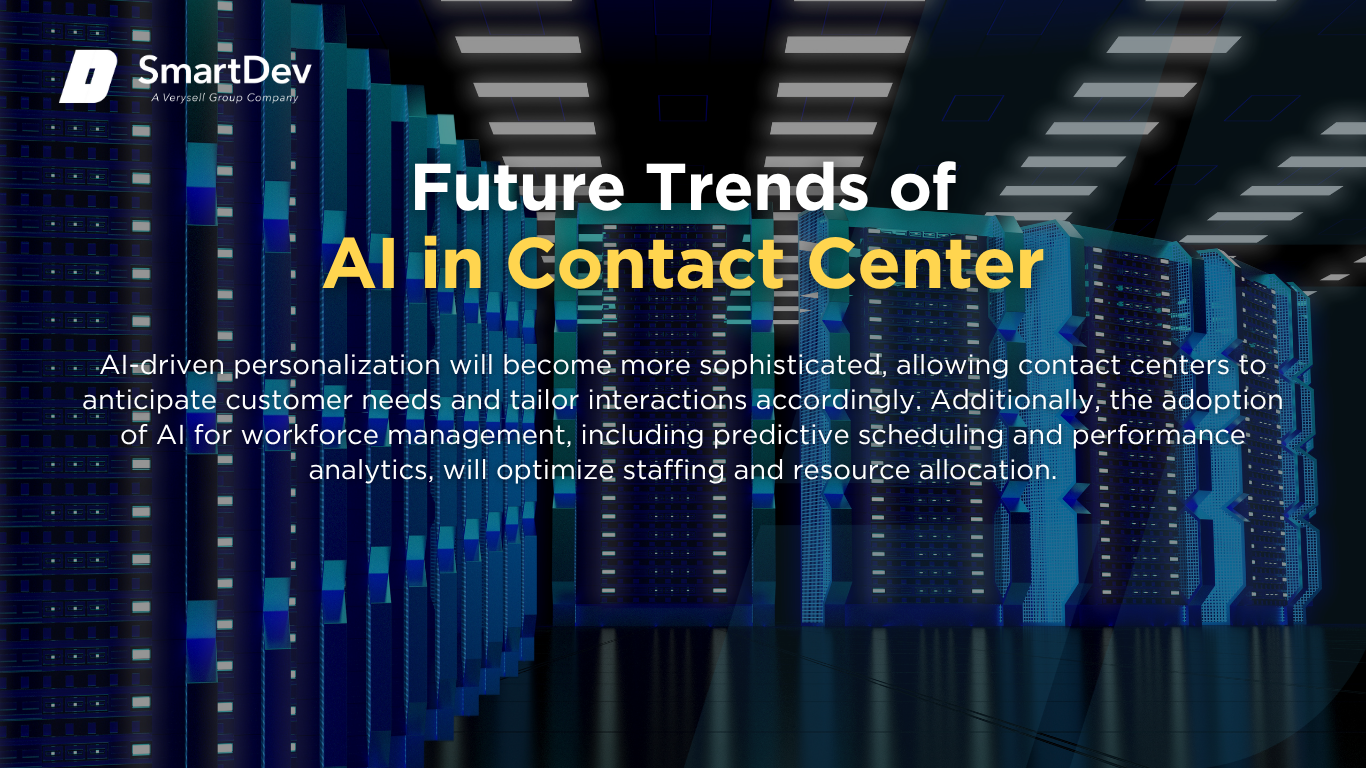
1. Predictions for the Next Decade
Over the next decade, AI is expected to become increasingly integral to contact center operations.
Advancements in natural language processing and machine learning will enable AI systems to handle more complex interactions with greater accuracy and empathy.
The integration of multimodal AI, combining text, voice, and visual data, will further enhance customer engagement and support.
AI-driven personalization will become more sophisticated, allowing contact centers to anticipate customer needs and tailor interactions accordingly.
Additionally, the adoption of AI for workforce management, including predictive scheduling and performance analytics, will optimize staffing and resource allocation.
These developments will position AI as a cornerstone of customer service excellence.
2. How Businesses Can Stay Ahead of the Curve
To remain competitive in the evolving landscape of AI-enhanced contact centers, businesses must adopt a proactive approach.
Investing in research and development will enable organizations to stay abreast of emerging technologies and identify opportunities for innovation.
Collaborating with AI vendors and industry experts can provide valuable insights and accelerate adoption.
Fostering a culture of agility and continuous improvement will empower teams to adapt to technological advancements and changing customer expectations.
Regularly reviewing and updating AI strategies ensures alignment with business objectives and market trends.
By embracing these practices, organizations can leverage AI to deliver exceptional customer experiences and drive sustainable growth.
Conclusion
Key Takeaways
AI is transforming contact centers by enhancing efficiency, personalization, and customer satisfaction.
Emerging technologies like generative AI and computer vision are enabling more sophisticated interactions, while AI-driven analytics and automation streamline operations.
Successful implementation requires careful planning, robust data management, and ongoing employee training.
Measuring ROI through key performance metrics and learning from case studies can guide organizations in maximizing AI benefits.
Moving Forward: A Path to Progress
Now is the time to act. If you’re leading a contact center and aiming to elevate service quality, reduce operational costs, and future-proof your customer experience strategy, integrating AI isn’t just an option—it’s a strategic imperative.
Start small, assess your current capabilities, and explore partnerships with trusted AI vendors. The landscape is evolving fast, and the early adopters are already reaping significant benefits. Don’t get left behind—embrace the AI revolution in contact centers and position your business for long-term success.
At SmartDev, we help contact centers harness the full potential of AI to boost efficiency, enhance customer experience, and scale with confidence. Thinking about bringing AI into your contact center? Let SmartDev guide the way—start with a customized pilot project today.
—
References:
- AI Voice Agents Are Ready to Take Your Call
- How Generative AI Can Be Used in the Contact Center
- The Contact Center Crossroads: Finding the Right Mix of Humans and AI
- AI in the Contact Center: Benefits & 6 Powerful Examples
- Is This the Year of the Artificial Intelligence Call Center?
- How Generative AI Is Transforming the Customer Service Experience







